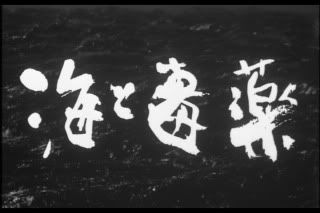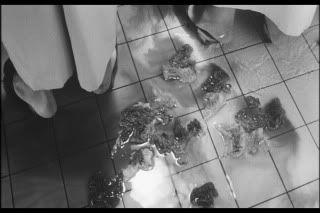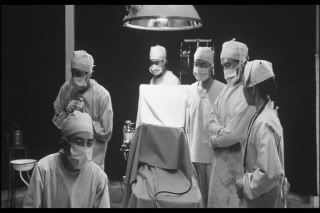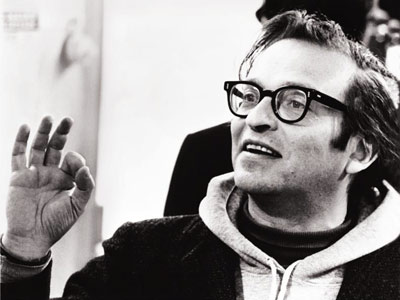Anthology films are a popular and cost-effective avenue for a no-budget filmmaker as they allow for an inconsistent shooting schedule, they can be assembled slowly when actors and resources are available, and the short running time of each segment can help avoid the pacing and story problems which so often plague films shot on video. All of that said, aside from some notable exceptions, anthology films are almost always terrible, as it takes serious skill to be able to tell a satisfying story in such a brief amount of time.
Scarlet Fry's Junkfood Horrorfest (incorrectly titled "Scarlett Fry" on the DVD) is a particularly poor and bloated example of the genre with six separate segments (as well as an intro and linking segments hosted by the titular Scarlet Fry) all fitting into the film's brief 66 minute run-time.
We begin with a completely superfluous introduction where a junkie (played by Alice Cooper's daughter Calico Cooper) beats a dealer to death with a tire iron for giving her a VHS tape instead of dope. She grabs some guy off the street (while she's still covered in blood) and the two sit down to watch the movie which - surprise - ends up being the film we're watching! It's both meta AND padding. We then see our horror host Scarlet Fry, who is basically an evil redneck demon who cracks off-color jokes while a woman is tied up behind him. I have a lot of forgiveness for the horror host tradition, and recognize that lame jokes are par for the course, but these segments are all pretty uninteresting. Fry (real name Walter Ruether) is enthusiastic, but totally forgettable. I'll summarize the film's segments, as they are all less than ten minutes each.
Bloodthirsty Butcher - A fat guy sits in his apartment complaining to himself about being hungry. He meets a young woman in the laundry room and invites her back to his apartment for lunch. Once there he strangles her, chops her up with a butcher knife and gnaws on a fake rubber arm.
Yes, this is the whole bit. There's no twist or joke, and there's no actual story being told. And that sets the pattern for the rest of the films, which are really more a series of vignettes than traditional anthology sequences. The most notable thing about
Bloodthirsty Butcher is the awful dubbing which takes place in the laundry room (probably not a great place to record sound at the best of times), and the very fact that the filmmakers believed that "fat hungry guy eats someone" was enough of a story to waste our time with.
The Solution - Shot in B&W (for some reason) this segment shows a nurse pushing an (unconvincing) older gentleman in a wheelchair through a park. When they stop for a moment for lunch, he refuses to be fed and obviously irritates her. Meanwhile a guy parks his car nearby, takes a rifle out of the trunk and shoots the old man. The nurse jumps around happily and hugs the guy and they drive off together.
Possibly the worst segment in the whole collection, and that's saying something. Pointless and unfunny. Any hope I had for the rest of this movie was totally crushed by the end of this segment.
Back with Scarlet and he crushes the skull of a woman who asks for directions to a hospital. Ha ha?
Griptape Spank - While the first two segments are simply lame and boring, this one is more actively offensive. Three skater punks - who speak the most ridiculous skater "lingo" I've heard since
Gleaming The Cube - need five dollars to buy some pot. Donnie, the leader of the pack, convinces his two pals to come with him to a parking garage where they proceed to spank a RIDICULOUS "gay" character with their skateboards for cash. After buying weed, the three go back to Donnie's place where his friends ridicule him for the whole spanking thing (even though they joined in) and he's emasculated by his girlfriend ("I thought I was with a man, not a little faggot."). After some bad dreams where he's further mocked, Donnie takes out his frustration by hammering nails into his skateboard and beating the gay guy to death. He comes home and goes back to bed, but after waking up his girlfriend continues to make fun so he smothers her to death. THE END.
You could read into this plot summary that Directors/Writers Brian Crow and Walter Ruether were actually poking fun at some of the homophobia prevalent in youth culture. Perhaps Donnie's own confused sexuality makes him act out violently when confronted. However, Ruether's later film
Nightmare Alley (2010) features another vignette where a homosexual is killed for propositioning someone at a bus stop, so I'd suggest that something much more malevolent and unpleasant is being suggested here.
Wasted Life - Thankfully, we get some lighter material here. A guy (played by the director) - who apparently lives in the same apartment as the
Bloodthirsty Butcher in the first segment - gets into a tub and slits his wrist while slash metal plays.
Well, that's certainly depressing. We know nothing about the person except that it's hinted he's broken up with his girlfriend, and he writes a brief suicide note. None of it is very convincing or disturbing, which makes you wonder why it's here in the first place. Though, I suppose the same could be said for the entire production.
Back with Scarlet Fry where one of his victims gets loose so he has to kill her. Inspired!
The Devil Made Me Do It - A woman witnesses her boyfriend performing a satanic ceremony and - after a brief argument where he threatens to kill her if she leaves - she shoots him. Leaving the body on the floor she decides to have a shower, and when she comes out he chokes her and then pulls out her guts.
Stupid and awful, of course. But it does feature one of the most unconvincing phone conversations I've ever seen in a film. The woman picks up the receiver and immediately starts talking, and then once she finishes she immediately puts it down without giving any sort of indication that there was someone on the other end. The acting is particularly bad here.
And with that we get a goodbye from Scarlet Fry and the credits begin to roll. But wait, the credits stop and a voice-over tells us that there's one more tale to be told. This one must be special if they left it until the end, right?
Love is Blind - A woman tells her asshole boyfriend that she thinks she might be pregnant. He acts like a jerk, so when she comes back the next day she pretends to seduce him before sticking pins in his chest, sewing his mouth shut and poking out his eye. She then laughs maniacally.
This one is the most creatively violent of all of the segments, but it also features the worst displays of acting - and that's saying something. As well, while the guy is clearly a dick, torturing and murdering him seems like a bit of an overreaction, and her transition to "homicidal" doesn't really make any sense. And that's it. This was so bad it had me begging for the work of Todd Sheets.
Scarlet Fry's Junkfood Horrorfest is presented in perfectly watchable (in terms of visual quality) full-screen without any noticeable glitches. Aside from the bad dubbing in
Bloodthirsty Butcher the audio is generally clear and comprehensible. Some music was composed by Alice Cooper guitarist Ryan Roxie, which along with Cooper's daughter making a brief appearance at the beginning would constitute something resembling star-power, but it's all forgettable, generic rock.
An anthology film would be really suited to having chapter stops. But, this being a Bloody Nightmares disc, we get no chapter stops or bonus features (unless you count that final segment, and I don't).
While stronger technically than many of the films in the Bloody Nightmares collection,
Scarlet Fry's Junkfood Horrorfest is wholly unpleasant and features not one segment that is even tolerable for an average viewer. The acting and writing are absolutely pitiful, and even my most modest expectations for entertainment were quickly snuffed out by the pointless vignettes. The filmmakers obviously had some willing actors and reasonable equipment, so that the result is so god-awful is truly inexcusable. Stay far away from this one.















































